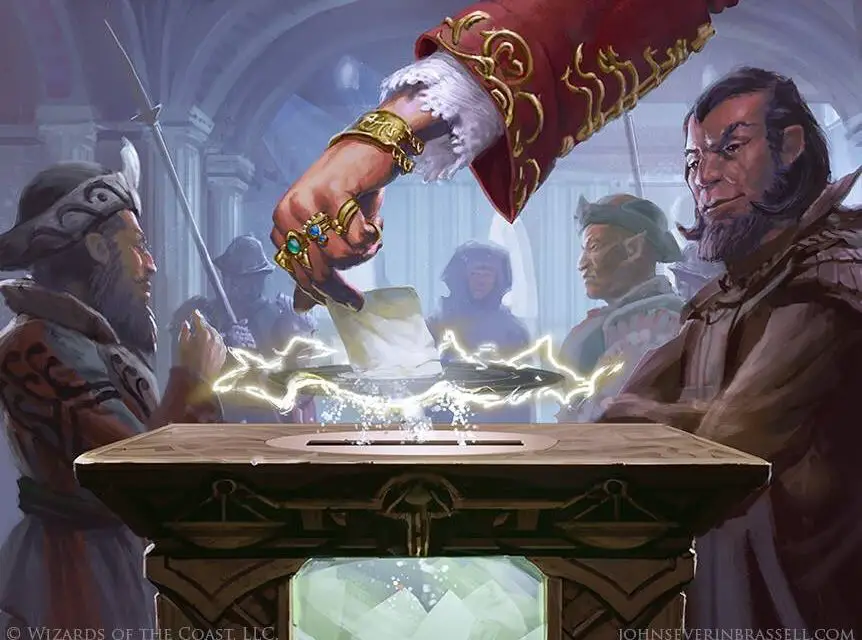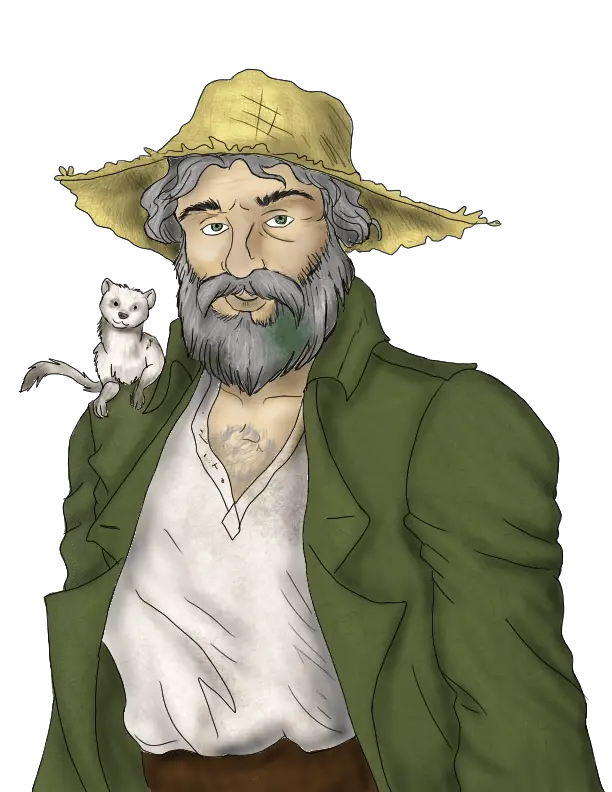Today, we’re diving into one of the most intriguing cantrips in D&D 5e: Minor Illusion.
Among the myriad of spells that can shape your destiny, cantrips hold a special place. These low-level spells are the bread and butter of any spellcaster, offering versatility and utility without depleting precious spell slots.
In this article, we’ll explore what makes Minor Illusion such a fascinating and versatile spell. We’ll break down its mechanics, share tips on how to use it creatively and effectively, and weigh its pros and cons. By the end, you’ll be ready to weave illusions that baffle your foes and delight your allies.
So grab your spellbook, and let’s get started on this magical dive into the power of Minor Illusion!
What is Minor Illusion 5e?
Minor Illusion is a cantrip that lets you create a simple yet convincing illusion within a 30-foot range.
With just a flick of your wrist and a bit of fleece, you can conjure a sound or an image of an object no larger than a 5-foot cube. The sound could be anything from a whisper to a scream, while the image might be a treasure chest, a set of footprints, or even a menacing shadow. The illusion lasts for up to one minute, or until you decide to dispel it.
It’s a versatile trick that can confuse enemies, distract guards, or even send a message—without costing you a single spell slot!
LEVEL: Cantrip
CASTING TIME: 1 Action
RANGE/AREA: 30 ft (5ft cube)
COMPONENTS: S, M*
DURATION: 1 Minute
SCHOOL: Illusion
ATTACK/SAVE: None
DAMAGE/EFFECT: Control
SPELL LISTS: Bard, Sorcerer, Warlock, Wizard
You speak a one-word command to a creature you can see within range. The target must succeed on a Wisdom saving throw or fYou create a sound or an image of an object within range that lasts for the duration. The illusion also ends if you dismiss it as an action or cast this spell again.
If you create a sound, its volume can range from a whisper to a scream. It can be your voice, someone else’s voice, a lion’s roar, a beating of drums, or any other sound you choose. The sound continues unabated throughout the duration, or you can make discrete sounds at different times before the spell ends.
If you create an image of an object–such as a chair, muddy footprints, or a small chest–it must be no larger than a 5-foot cube. The image can’t create sound, light, smell, or any other sensory effect. Physical interaction with the image reveals it to be an illusion, because things can pass through it.
If a creature uses its action to examine the sound or image, the creature can determine that it is an illusion with a successful Intelligence (Investigation) check against your spell save DC. If a creature discerns the illusion for what it is, the illusion becomes faint to the creature.
* (a bit of fleece)

How to Use Minor Illusion 5e Effectively
Ready to turn the mundane into the magical? Minor Illusion is your ticket to endless creativity and cunning strategies.
Here’s how to make the most out of this versatile cantrip:
Creative Uses in Gameplay
- Distract and Divert: Need to slip past a guard? Create the sound of footsteps or a distant conversation to lure them away. Or conjure an image of a shiny object to catch their eye while you sneak by.
- Hide in Plain Sight: Transform a section of the wall into a door or a stack of crates to hide behind. While the illusion won’t provide physical cover, it can still fool enemies into thinking you’re not there.
- Mimic Environmental Sounds: Recreate the sound of a creaky floorboard, a dripping faucet, or even a growling beast to add layers of deception and confusion.
- Silent Communication: Need to relay a message without speaking? Use Minor Illusion to create written messages or simple images that convey your intentions to your party.
Tactical Applications
- Ambush Setup: Create the illusion of treasure or an injured ally to lure enemies into a trap. Once they’re in position, spring your ambush and catch them off guard.
- Escape Strategies: Need a quick getaway? Create an illusory wall to block a passage or a set of decoy footprints to mislead your pursuers. Every second counts when you’re making a narrow escape.
- Misleading Opponents: In combat, use Minor Illusion to create false threats or hide hazards. An illusory pit or a snarling beast can force enemies to rethink their approach or waste precious actions.
Minor Illusion is really all about thinking outside the box. The more creatively you use it, the more effective it becomes. So, don’t be afraid to experiment and let your imagination run wild.
With Minor Illusion at your fingertips, you’ll always have a trick up your sleeve!

Pros and Cons of Minor Illusion 5e
Minor Illusion is like the Swiss Army knife of cantrips—compact, versatile, and incredibly handy in a pinch.
However, like any tool, it has its strengths and limitations.
Let’s break down the pros and cons of this magical gem.
Pros
- Versatility Galore: Whether you need to create a diversion, hide an object, or communicate secretly, Minor Illusion has got you covered. Its applications are only limited by your imagination.
- No Resource Cost: Being a cantrip, you can cast Minor Illusion as often as you like without burning through your precious spell slots. This makes it a reliable go-to spell for any situation.
- Quick and Easy: With a casting time of just one action, you can whip up an illusion in the heat of the moment. Need a quick distraction? Minor Illusion to the rescue!
- Great for Role-Playing: This spell shines in creative role-playing scenarios. Use it to enhance your storytelling, set the mood, or add a touch of mystery to your character’s actions.
Cons
- Size Matters: The illusion is limited to a 5-foot cube, which means you can’t conjure anything larger than a small object or a confined sound. No creating illusory dragons or sprawling landscapes here!
- Static Images: Visual illusions created by Minor Illusion are static and can’t move. This limits their effectiveness in dynamic situations where movement is key.
- Easily Dispelled: A creature that uses its action to examine the illusion can determine it’s a fake with a successful Intelligence (Investigation) check against your spell save DC. Once the jig is up, the illusion becomes faint to that creature.
- Lack of Sensory Depth: The illusion can’t produce sensory effects beyond sight and sound. No smells, tastes, or tactile sensations, which can sometimes break the immersion for keen-eyed foes.
Despite these limitations, Minor Illusion remains a powerful tool in any clever spellcaster’s arsenal.
Its strengths lie in its flexibility and the creativity it encourages. Use it wisely, and you’ll have your enemies second-guessing reality itself!
FAQs – Minor Illusion 5e
The illusion is limited to a 5-foot cube, meaning it can only create small objects or sounds. Additionally, the illusion is static and cannot move once created.
While it can produce visual and auditory effects, it cannot generate smells, tastes, or tactile sensations. This means your illusions might not hold up under close scrutiny or physical interaction.
No, once you create an illusion with Minor Illusion, it remains static for its duration.
This means that if you conjure an image of a treasure chest, it will stay in the same spot and won’t open or close. Similarly, a sound will emanate from a fixed point and won’t follow a moving character or object.
If you need dynamic illusions, you might want to consider other spells like Silent Image or Major Image.
Dungeon Masters should encourage creativity while maintaining a balance between fun and fairness. When players come up with inventive uses for Minor Illusion, consider the context and the spell’s limitations.
If a player tries to push the boundaries, remind them of the spell’s constraints, such as the size limit and the static nature of the illusion. Use Intelligence (Investigation) checks to determine if NPCs or monsters see through the illusion, and reward clever thinking with appropriate in-game benefits.
While Minor Illusion can create detailed images, the complexity is limited by the size constraint (a 5-foot cube) and the fact that the image is static. You can create an image with intricate details, like a small statue or a piece of parchment with writing, but it won’t be able to move or change once created.
For more complex illusions that require movement or interaction, you might need to use higher-level illusion spells.
Conclusion – Minor Illusion 5e
Minor Illusion is a spell that packs a punch far beyond its humble cantrip status. With its endless potential for creativity and strategy, it’s a must-have tool for any spellcaster looking to add a bit of flair and cunning to their repertoire.
Whether you’re conjuring distractions, crafting clever escapes, or just having a bit of fun, Minor Illusion is your trusty sidekick in the world of Dungeons & Dragons.
But now it’s your turn to sound off!
We’d love to hear your thoughts and stories about how you’ve used Minor Illusion in your games. Share your experiences and tips in the comments below.
And if you’re hungry for more magical insights and tabletop tips, don’t forget to sign up for the Tabletop Joab newsletter. Join our community of passionate gamers and stay up-to-date with the latest articles, guides, and exclusive content.









